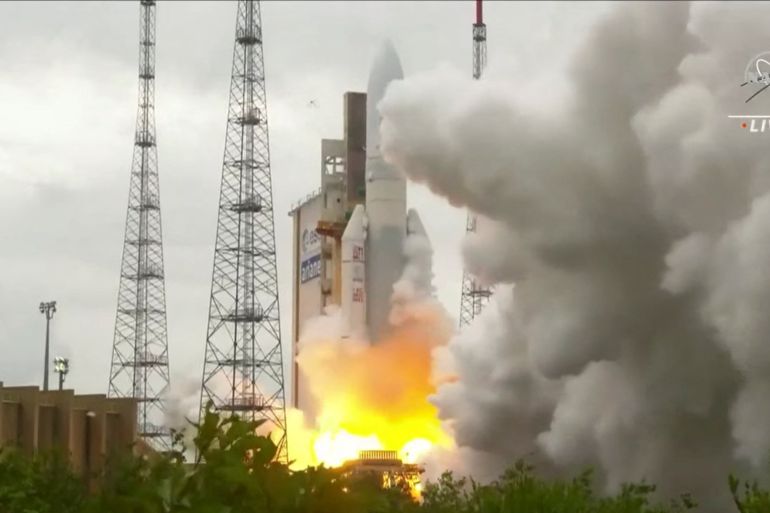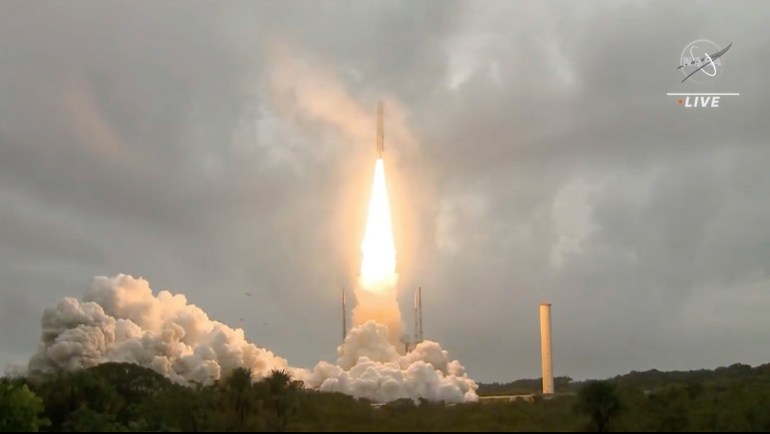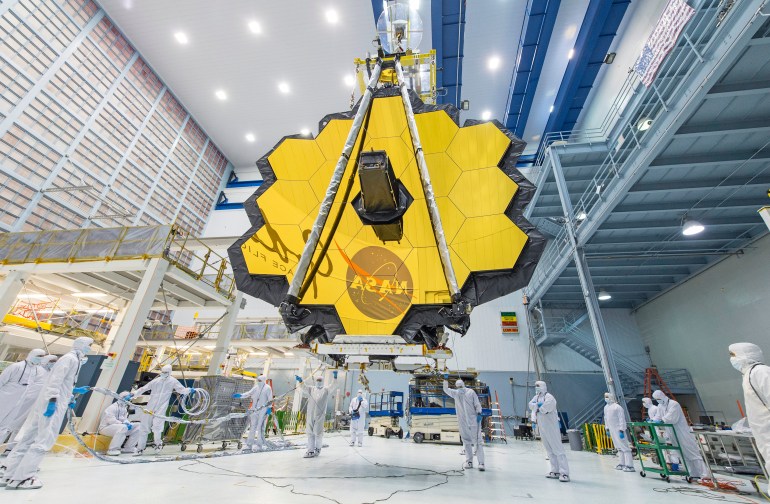James Webb Space Telescope, world’s largest, lifts off into orbit
The $9bn observatory seeks out faint light from the first stars and galaxies, providing a glimpse into cosmic creation.

The world’s largest and most powerful space telescope has rocketed away on a high-stakes quest to behold light from the first stars and galaxies and scour the universe for hints of life.
NASA’s James Webb Space Telescope soared from French Guiana on South America’s northeastern coast, riding a European Ariane rocket into the morning sky on Saturday.
Keep reading
list of 4 itemsDebris risk forces NASA to delay mission to fix ISS antenna
NASA launches ‘suicide’ spacecraft to kick asteroid off course
Space debris: The rubbish you didn’t see coming
The $9bn observatory hurtled towards its destination 1.6 million kilometres (1 million miles) away – or more than four times beyond the moon. It will take a month to get there and another five months before its infrared eyes are ready to start scanning the cosmos.
First, the telescope’s enormous mirror and sunshield need to unfurl; they were folded origami-style to fit into the rocket’s nose cone. Otherwise, the observatory will not be able to peer back in time 13.7 billion years as anticipated, within a mere 100 million years of the universe-forming Big Bang.
“It’s going to give us a better understanding of our universe and our place in it: who we are, what we are, the search that’s eternal,” NASA Administrator Bill Nelson said earlier this week.
But he cautioned: “When you want a big reward, you have to usually take a big risk.”

Reporting from Kourou, French Guiana, Al Jazeera’s Manuel Rapalo said the historic mission which has “revolutionised astronomy” is “going to allow scientists to peer back in time to the early stages of our universe”.
“Scientists are also going to be able to examine the atmospheres of planets and determine whether or not planets could not only be habitable and suitable for humans to possibly one day colonise, but to determine whether or not those conditions are optimal for life,” he said.
‘Launch for humanity’
Intended as a successor to the ageing Hubble Space Telescope, the long-delayed James Webb is named after NASA’s administrator during the 1960s.
NASA partnered with the European and Canadian space agencies to build and launch the new 7-tonne telescope, with thousands of people from 29 countries working on it since the 1990s.
Around the world, astronomers had eagerly waited to see Webb finally taking flight after years of setbacks. Last-minute technical snags bumped the launch nearly a week, then gusty wind pushed it to Christmas.
“We launch for humanity this morning,” Arianespace CEO Stephane Israel said minutes before liftoff. “After Webb, we will never see the skies in quite the same way.”
Klaus Pontipiddan, one of the scientists involved in the Webb Project, told Al Jazeera from Baltimore, US that it was “a beautiful launch”.
“It was just beautiful to see everything went off without a hitch,” he said. “We hope that we can now see the first galaxies formed in the universe almost 13-and-a-half billion years ago.”
The telescope’s showpiece: a gold-plated mirror more than 6.5 metres (21 feet) across.

Protecting the observatory is a wispy, five-layered sunshield, vital for keeping the light-gathering mirror and heat-sensing infrared detectors at subzero temperatures. At 21 by 14 metres (70 by 46 feet), it is the size of a tennis court.
If all goes well, the sunshield will be opened three days after liftoff, taking at least five days to unfold and lock into place. Next, the mirror segments should open up like the leaves of a drop-leaf table, 12 days or so into the flight.
In all, hundreds of release mechanisms need to work perfectly in order for the telescope to succeed. “Like nothing we’ve done before,” NASA programme director Greg Robinson said.